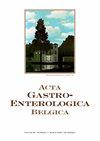研究胆道插管困难患者早期预切瘘成功率及其对放射剂量的影响
IF 1.5
4区 医学
Q2 Medicine
引用次数: 0
摘要
背景:在困难的选择性胆道插管中,切开前瘘管切开术在减少透视时间和放射剂量方面的作用尚不清楚。方法:采用随机试验方法,将胆道插管困难患者随机分为2组:早期预切瘘管(标准胆道插管失败后5分钟预切)和晚期预切瘘管(标准胆道插管失败后15分钟预切)。我们比较了选择性胆道插管的成功率、透视时间、放射剂量、并发症发生率、需要重复内镜逆行胆道造影(ERC)和需要其他干预措施。结果:在筛选的130例符合条件的患者中,随机选择了40例患者。技术上的成功在早组和晚组之间是相当的。早期组的透视时间和放射剂量均明显少于[4分钟(3,6)vs 15分钟(8,28),p=0.001]和[1.35 mGy (0.90, 1.63) vs 2.40 mGy (1.58, 3.25), p=0.010]。晚期组中,60%需要行抢救性预切瘘术。晚期组1例发生ERC后胰腺炎,早期组1例发生穿孔。由于第二次尝试失败,其中3人需要其他干预。结论:在胆道插管困难的情况下,早期预切瘘管与晚期预切瘘管相比,在技术上取得了相当的成功,并减少了放射剂量。本文章由计算机程序翻译,如有差异,请以英文原文为准。
A pilot randomized trial to study the success rate of early precut fistulotomy and its effect on radiation dose in patients with difficult biliary cannulation
Background: Role of precut fistulotomy in reducing fluoroscopy time and the radiation dose in difficult selective biliary cannulation is unknown.
Methods: We performed a randomized trial where patients with difficult biliary cannulation were randomized into 2 groups: early precut fistulotomy (precut five minutes after failed standard biliary cannulation) or late precut fistulotomy (precut fifteen minutes after failed standard biliary cannulation). We compared the success rates of selective biliary cannulation, fluoroscopy time, radiation dose, complication rates, need for repeat endoscopic retrograde cholangiography (ERC) and need for other interventions
Results: Of the 130 eligible patients screened, 40 patients were randomized. The technical success was comparable between early and late group. The fluoroscopy time and radiation dose were significantly less in the early group [4 minutes (3, 6) vs 15 minutes (8, 28), p=0.001] and [1.35 mGy (0.90, 1.63) vs 2.40 mGy (1.58, 3.25), p=0.010] respectively. In the late group, 60% required need for rescue precut fistulotomy. One patient from late group developed post ERC pancreatitis while 1 from early group developed perforation. Three needed other interventions due to failed second attempt.
Conclusion: Early precut fistulotomy has comparable technical success and reduces the radiation dose as compared to late precut fistulotomy for difficult biliary cannulation.
求助全文
通过发布文献求助,成功后即可免费获取论文全文。
去求助
来源期刊

Acta Gastro-Enterologica Belgica
医学-胃肠肝病学
CiteScore
2.80
自引率
20.00%
发文量
0
审稿时长
>12 weeks
期刊介绍:
The Journal Acta Gastro-Enterologica Belgica principally publishes peer-reviewed original manuscripts, reviews, letters to editors, book reviews and guidelines in the field of clinical Gastroenterology and Hepatology, including digestive oncology, digestive pathology, as well as nutrition. Pure animal or in vitro work will not be considered for publication in the Journal. Translational research papers (including sections of animal or in vitro work) are considered by the Journal if they have a clear relationship to or relevance for clinical hepato-gastroenterology (screening, disease mechanisms and/or new therapies). Case reports and clinical images will be accepted if they represent an important contribution to the description, the pathogenesis or the treatment of a specific gastroenterology or liver problem. The language of the Journal is English. Papers from any country will be considered for publication. Manuscripts submitted to the Journal should not have been published previously (in English or any other language), nor should they be under consideration for publication elsewhere. Unsolicited papers are peer-reviewed before it is decided whether they should be accepted, rejected, or returned for revision. Manuscripts that do not meet the presentation criteria (as indicated below) will be returned to the authors. Papers that go too far beyond the scope of the journal will be also returned to the authors by the editorial board generally within 2 weeks. The Journal reserves the right to edit the language of papers accepted for publication for clarity and correctness, and to make formal changes to ensure compliance with AGEB’s style. Authors have the opportunity to review such changes in the proofs.
 求助内容:
求助内容: 应助结果提醒方式:
应助结果提醒方式:


